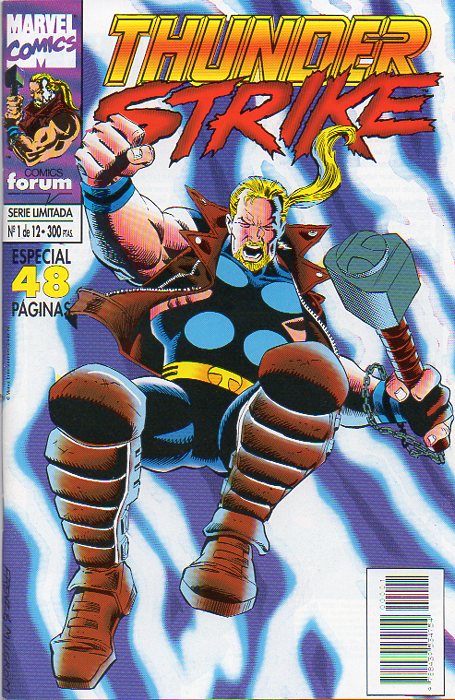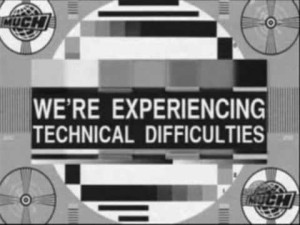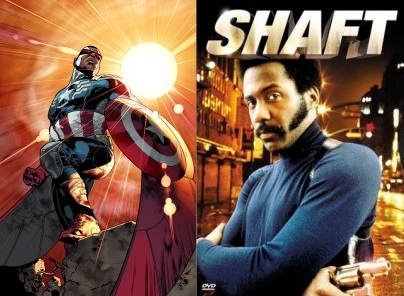On the inaugural episode of Heavy Meta on One of Us, Vince leaps to the defense of media that panders to a certain audience. Is it just an annoyance, or a necessary step in giving wider demographics a voice? Read on, true believers!
The simultaneous announcements that Sam Wilson (aka The Falcon) will soon be picking up the shield of Captain America, and that Thor will be getting in touch with his feminine side in the coming months, have been met with a mixed reaction.
On one hand, this is clearly a victory for diversity in comics, offering something new for those tired of reading the latest edition of White Guy Adventures Monthly. But it’s perhaps the combination of these announcements, in tandem with Marvel declaring that they would essentially be turning Tony Stark into a maniacal app developer, that has the comic book giant starting to look like your awkward uncle’s desperate attempts to prove that he’s “hip to what you kids like.”
Many of the geek persuasion have leapt to their message board of choice with cries of “PANDERING!!!”, fearing that their beloved characters might have their best qualities undermined for the sake of another Marvel attention grab. While their concerns might be founded…

…the reality is that often-times, pandering is the awkward pubescent stage that media needs to go through in order to break out of a rut and introduce something new. Ham-fisted storytelling is the patchy facial hair of fiction; an unwanted but necessary stage it must endure while trying to find its footing and developing into something worth sticking with for the long-haul. But to truly take a look at how pandering laid the foundations for many of the conventions we take for granted, we have to take a hop in the way-back machine all the way to the 1970’s. *insert screen-wiggle here*
Blaxploitation THEN and Marvel NOW
Following the abolition in the 60’s of various segregation laws concerning hiring and business practices, black Americans suddenly found themselves with buying power in a market they’d never before experienced. In a bid to capture some of the newfound market, the film industry rushed to put black actors at the forefront of big screen productions, culminating in what’s known today as the ‘Blaxploitation’ era of film.
The name Blaxploitation comes from the fact that the majority of these movies didn’t have much going for them aside from the inclusion of black heroes. Most of the time, they were filled with community drama-level acting, terrible scripts, and more plotholes than you could shake an inevitably on-camera boom mic at. The thing was, those who held the purse strings were unsure as to whether or not black people were actually worth the investment as an audience (as quaint a notion as that is today), because this was the first time they’d ever even been a market worth considering.
As such, the typically conservative business philosophy that drives the entertainment business similarly drove a wedge between the desire to take advantage of a new market sect, and the fear of dumping money into something unproven. The unsatisfying compromise resulted in shoestring budgets, and the ramshackle quality that you see in many a Blaxploitation production.
However, the story doesn’t end there. While this era of film isn’t known as producing cinema classics, it did play an absolutely crucial role that still resonates today: it proved that you could have black people in film, as leading characters, and people would go see it. It showed that you could write stories that, while stereotypical, reflected the realities of a portion of the population that never before had a voice, and people would go see them.
Blaxploitation’s emergence, stumbling and tripping into the light of public perspective seems clumsy to us today, but the reality is that great actors such as Morgan Freeman, James Earl Jones, or Denzel Washington may have never gotten a shot if Blaxploitation hadn’t shown boardroom Hollywood that your typical melanin-blessed thespian deserved a shot. Furthermore, if the film industry hadn’t opened its eyes to the incredible talent present, we may never have gotten such legendary performances in movies like Shawshank Redemption or Training Day.
People often make the mistake of believing that first attempts are indicative of the way things will forever be (comics will always be for kids; a black man could never be President, etc). But truth is, they aren’t. The tricky bit is that often times, attempts at changing the status quo seem doomed to failure (in ANY arena, not just entertainment) because the infrastructure and understanding to support such a change simply isn’t there yet. Sure, a black man may never have been President before the sixties, but the aforementioned discriminatory laws might have something to do with that. The comics of 40’s, 50’s, and 60’s may seem juvenile by today’s standards, but the limitations placed on their physical resources, budgets, and creative freedom (Comics Code, anyone?) kept them from realizing their full potential.
Returning to 2014, studio execs look at the shoddy sales for many female and minority heroes and say, “See? We can’t create this! It just doesn’t sell”, while those same titles are often given to the B-teams, are marketed poorly, or otherwise shoddily handled. But despite perceptions by the higher-ups, the all-seeing eye of the Internet has showed that, yes, women do read comics. Yes, people of Latino, Black, and Asian backgrounds want to see their lives and culture given a narrative voice. And if you write them well, they will pay through the nose to enjoy them.
Right now, Axel Alonso and his ilk are in much the same position that movie studios were in the seventies. Editorials and social media have shown a desire for greater diversity, but the old business philosophy of sticking with a good thing makes those at the top willing to take risks that might rock the boat.
So what do they do? They take a franchise character like Thor or Cap (one shown to have an established audience), and, rather than trying to create an entirely new character (and fanbase) from scratch, use the safety net of their existing brand penetration to test the waters. This way, they can see whether geeks will put their money where their mouths are when they bring a minority/female character to the forefront. This way, they can potentially expand the audience to include those same voices crying out for better representation, without risking the possibility of investing thousands of man-hours into creating a new character that may very well crash and burn, sales-wise.
The Times Are A-Changin’ (If We Let Them)
It’s one of the supreme ironies of being a comic book geek that we complain every time we see a ret-con take place that resets the status quo, yet also whinge and moan whenever something unexpected is announced for our favorite hero.

I think that Ed Catmull (president of Pixar and Disney Animation) put it best in Creativity Inc., where he notes that to make anything new, you have to risk failure and make mistakes. More importantly, you have to be willing to accept that for an idea to become great, you have to tolerate a period where it just isn’t very good. Ideas, just like anything else, need to find their feet, and rarely hit it out of the park on their first try.
Marvel may be going through an awkward period, using Sam Wilson as Captain America and Lady Thor to bring up sales, but if they aren’t encouraged for trying new things, they’ll just revert to the same status quo that had people tearing their hair out when the Devil decided that he had nothing better to do than fuck up someone’s marriage. I mean SERIOUSLY? You’re the FUCKIN’ DEVIL. HOW ABOUT SOME PLAGUES? CHILD SOLDIERS, MAYBE?! I DON’T KNOW, BUT I SWEAR TO G—”

..Sorry.
My point is that pandering, ham-handed storytelling, and first drafts are the ugly teenage molestache of the creative process that no one wants to acknowledge because we so often only see the final product. But in order to assuage creative companies into trying new things (and in the process work towards those awesome stories that become the stuff of legend) we have to try and be more tolerant towards missteps, and stop crying foul every time Malibu Stacy is given a new hat.
Vince Smith is a writer, podcast host, and dyed-in-the-wool geek of all trades. You can check out other articles and videos by him over at The Rogues’ Gallery, or drop by his Facebook Page, Vincent Smith: Writer, Scholar, Gentleman for other musings from the catacombs of the Internet.
-Written by Vincent Mendoza


